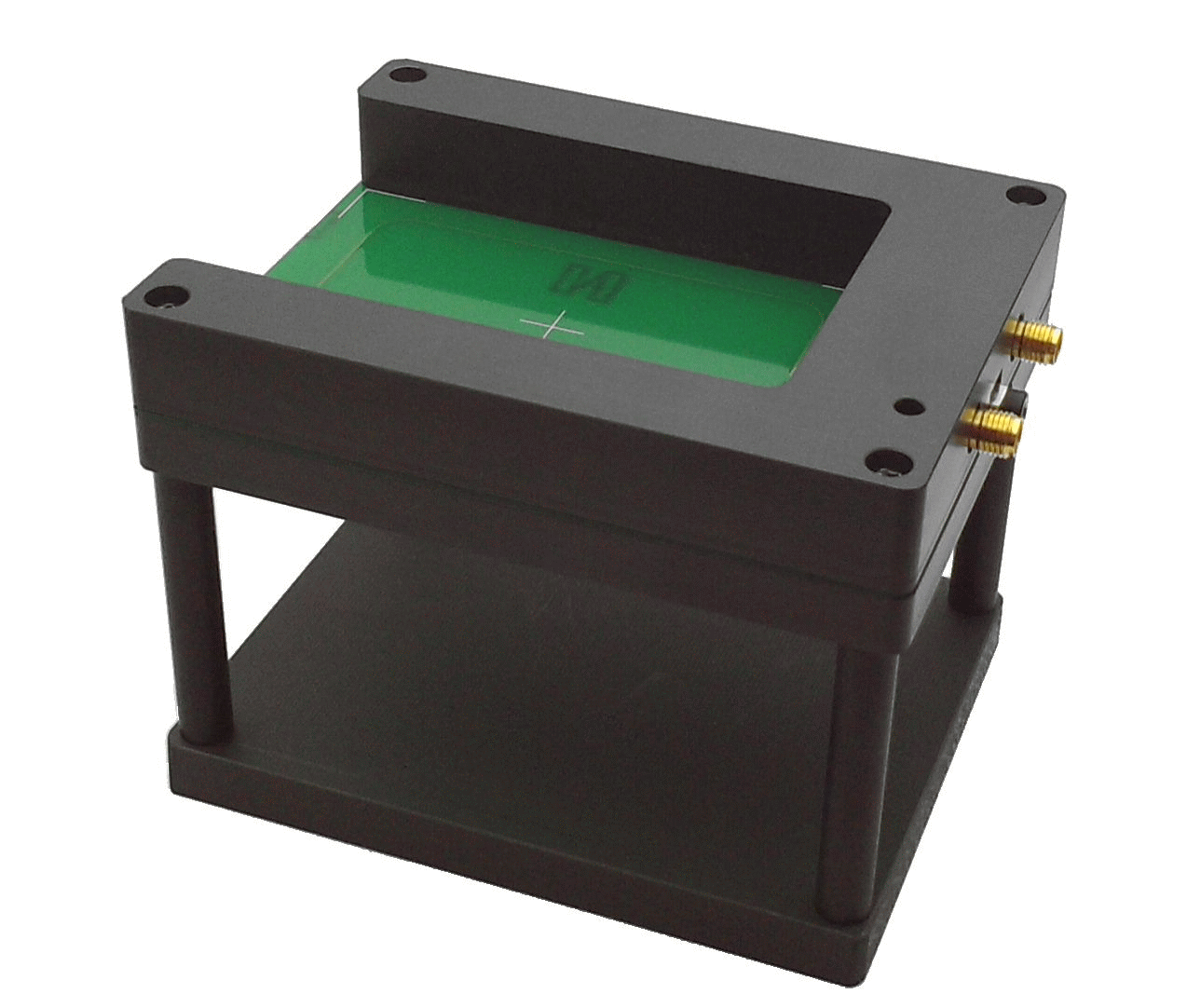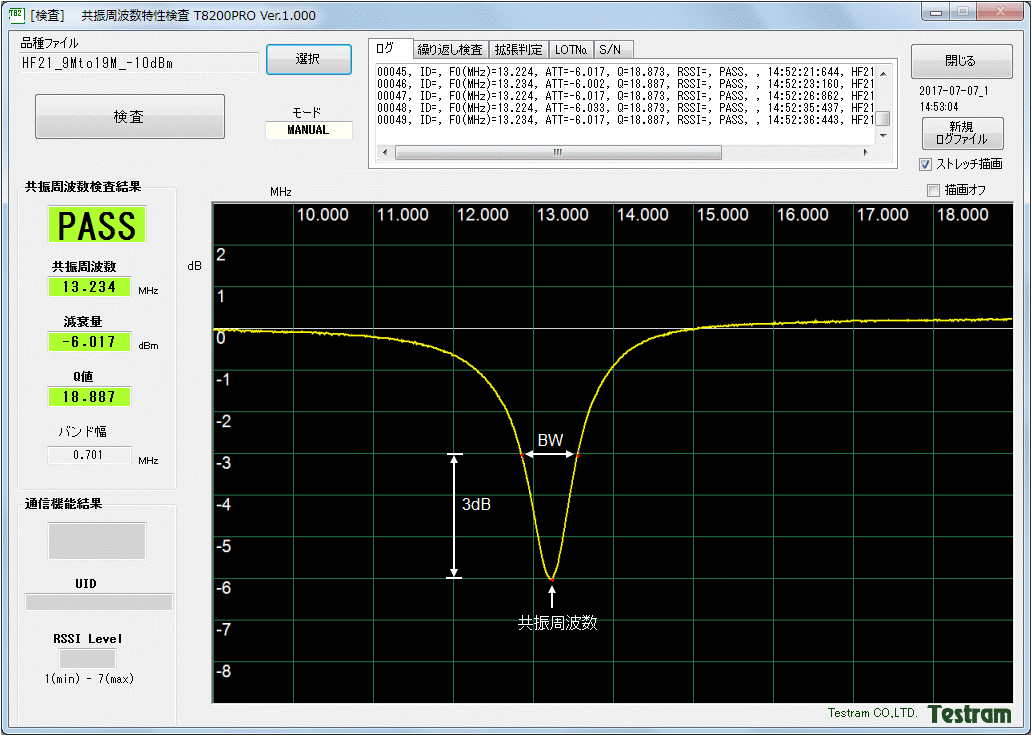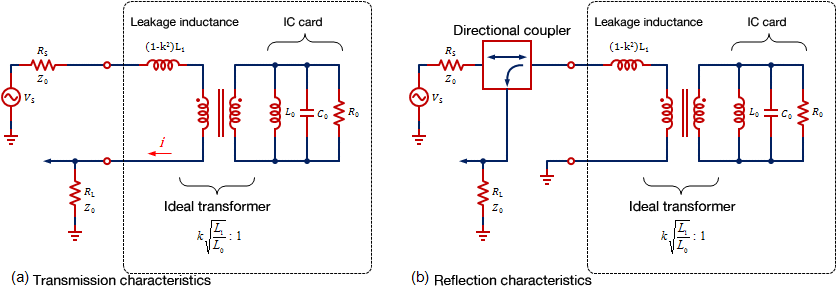[T8200PRO] Comparison of measurement results of resonance characteristics due to transmission and re
The T8200PRO is a device that inspects the resonance characteristics by placing a non-contact IC card on the inspection probe as shown in Fig. 1, and can inspect the resonance characteristics by transmission (S21) or reflection (S11). is. Here, we will explain the results obtained by measuring the transmission characteristics and reflection characteristics using the same inspection probe and IC card.

Figure 1 Inspection probe
Measurement principle
First, I will explain the measurement principle of the transmission characteristics and reflection characteristics of the T8200PRO. Figure 2 shows the equivalent circuit when a non-contact IC card is placed on the inspection probe. The inspection probe (loop antenna) is represented as an inductance L1, and the non-contact IC card is represented as a parallel resonant circuit consisting of L0, C1, and R0. Since L1 and L0 are magnetically coupled, they operate as a transformer.
Transmission characteristics: Fig. 2 (a)
- For transmission characteristics, a probe for inspection is connected in series to the signal path, a sine wave is applied, and the amplitude of the transmitted wave voltage that has passed through the measurement target is measured.
- When the IC card resonates, the voltage drop at the L1 part increases and the transmitted wave decreases.
- The amount of attenuation at the resonance frequency depends on the loss R0 of the IC card. The larger R0, the greater the attenuation.
Reflection characteristics: Fig. 2 (b)
- For the reflection characteristics, connect the T8200PRO and the inspection probe with a single coaxial cable (short the unused connector of the inspection probe), apply a sine wave, and measure the amplitude of the reflected wave voltage generated by the measurement target. ..
- When the IC card resonates, the energy of the incident wave is consumed by the IC card, so the reflected wave decreases.
- The amount of attenuation at the resonance frequency decreases so much that the measurement target matches 50Ω.

Measurement result
Fig. 3 shows the measurement result of the resonance characteristic by transmission, and Fig. 4 shows the inspection result of the resonance characteristic by reflection. For the setting method, refer to the setting method of resonance characteristic inspection by transmission and resonance characteristic inspection by reflection. Table 1 summarizes the measurement results.
Table 1 Comparison of measurement results of transmission characteristics and reflection characteristics
|
Transmission characteristics (S21)
|
Reflection characteristics (S11)
|
|
|
Resonance frequency
|
13.234 MHz
|
13.424 MHz
|
|
Attenuation amount
|
−6.0dB
|
−10.0dB
|
|
Load Q (QL)
|
18.9
|
9.6
|
|
No load Q (Qu)
|
26.7
|
25.18
|
The following can be seen from Table 1.
- The resonance frequency obtained from the reflection characteristics is about 200 to 300 kHz higher than the resonance frequency obtained from the transmission characteristics.
- The no-load Q obtained from the reflection characteristics and the no-load Q obtained from the transmission characteristics are about the same.

Fig. 3 Resonance characteristic inspection result by transmission

Fig. 4 Resonance characteristic inspection result by reflection
Resonance frequency
The reasons why the resonance frequency due to transmission and the resonance frequency due to reflection are different are as follows. Figure 5 shows the equivalent circuit drawn using an ideal transformer for each measurement method. RS and RL are signal source resistances (both 50Ω), and k is the coupling coefficient.
Transparency characteristics
In the transmission characteristics of Fig. 5 (a), when the IC card parts (L0, C0) resonate in parallel, the current i flowing through the circuit takes a minimum value. Therefore, the resonance frequency obtained by this measurement method is almost the resonance frequency of the IC card alone 1 / 2π√ (L0C0).
Reflection characteristics
On the other hand, regarding the reflection characteristics in Fig. 5 (b), since there is a leak inductance (1−k2) L1, impedance matching is performed because the entire circuit is inductive at the resonance frequency 1 / 2π√ (L0C0) of the IC card alone. However, it matches when the L0, C0, and R0 parts become slightly capacitive at frequencies slightly higher than that. In other words, it resonates at a frequency slightly higher (about 200 to 300 kHz) than in the case of transmission characteristics.
In the transmission characteristics of Fig. 5 (a), when the IC card parts (L0, C0) resonate in parallel, the current i flowing through the circuit takes a minimum value. Therefore, the resonance frequency obtained by this measurement method is almost the resonance frequency of the IC card alone 1 / 2π√ (L0C0).
Reflection characteristics
On the other hand, regarding the reflection characteristics in Fig. 5 (b), since there is a leak inductance (1−k2) L1, impedance matching is performed because the entire circuit is inductive at the resonance frequency 1 / 2π√ (L0C0) of the IC card alone. However, it matches when the L0, C0, and R0 parts become slightly capacitive at frequencies slightly higher than that. In other words, it resonates at a frequency slightly higher (about 200 to 300 kHz) than in the case of transmission characteristics.

Fig. 5 Equivalent circuit of transmission characteristics and reflection characteristics
Q value
The load Q (QL) is calculated by the following formula.
QL = f0 / BW, f0: Resonance frequency, BW: Bandwidth
Bandwidth BW should be such that the power consumed in the resonant circuit is half the peak value (the voltage drops by 3 dB). For the transmission characteristics (Fig. 3), the bandwidth is the level at which the attenuation is increased by 3 dB from the minimum value. For reflection characteristics (Figure 4), the bandwidth is the level that is 3 dB lower than the total reflection level (0 dB).
Since the load Q (QL) is the Q of the entire measurement system including the drive circuit and receiver circuit in addition to the measurement target and antenna (probe) (Q in Fig. 5 as a whole), the load Q and reflection characteristics obtained from the transmission characteristics The load Q obtained from can not be simply compared because the degree of influence of the drive circuit and the receiver circuit is different.
No-load Q (Qu) is the Q of the antenna (probe) part of the measurement target (Q of the dotted line part in Fig. 5). The no-load Q obtained from the transmission characteristics and the no-load Q obtained from the reflection characteristics are about the same value.
Since the load Q (QL) is the Q of the entire measurement system including the drive circuit and receiver circuit in addition to the measurement target and antenna (probe) (Q in Fig. 5 as a whole), the load Q and reflection characteristics obtained from the transmission characteristics The load Q obtained from can not be simply compared because the degree of influence of the drive circuit and the receiver circuit is different.
No-load Q (Qu) is the Q of the antenna (probe) part of the measurement target (Q of the dotted line part in Fig. 5). The no-load Q obtained from the transmission characteristics and the no-load Q obtained from the reflection characteristics are about the same value.
Conclusion
The results can be summarized as follows.
- The resonance frequency obtained from the reflection characteristics is about 200 to 300 kHz higher than the resonance frequency obtained from the transmission characteristics (however, this deviation depends on the degree of magnetic field coupling). The resonance frequency obtained from the transmission characteristics is close to the parallel resonance frequency of the IC card alone. The resonance frequency obtained from the reflection characteristics is the frequency when the entire circuit is impedance-matched and the power is transmitted to the maximum, which is higher than the parallel resonance frequency of the IC card alone.
- The no-load Q obtained from the reflection characteristics and the no-load Q obtained from the transmission characteristics are about the same value.
* However, it may not be possible to measure accurately depending on the measurement target. Please refer to the following for which inspection method to choose.
When the transmission characteristics are advantageous
- IC module unmounted tag.
- When the magnetic field coupling between the measurement target and the antenna (probe) is strong.
When the reflection characteristics are advantageous
- When multiple resonance points are created due to the influence of leakage inductance and it is not possible to measure well with the transmission characteristics.
- When the measurement target and the antenna (probe) are far apart, and the attenuation is small due to the transmission characteristics, making accurate measurement impossible.
